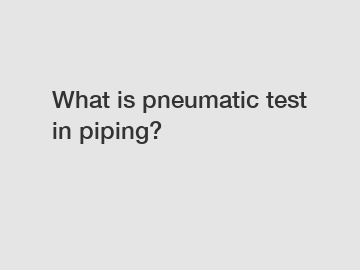What is pneumatic test in piping?
Pneumatic testing is a crucial procedure in the field of piping engineering. It involves conducting a pressure test using compressed air or gas to check the integrity and strength of pipes and components. This process helps ensure that the piping systems can safely handle the desired fluid flow and pressure. In this article, we will delve deeper into the concept of pneumatic testing in piping, its significance, process, and key considerations.
Significance of Pneumatic Test in Piping.
Maintaining the integrity of piping systems is vital to prevent catastrophic incidents or leaks that can result in potential hazards, loss of product, and environmental damage. Pneumatic testing plays a critical role in achieving this objective by identifying any weak points or defects within the piping network before it is put into operation.

H2: The Pneumatic Testing Process.
Pneumatic testing involves subjecting the piping system to a predetermined pressure, often higher than its intended operating pressure, to assess its structural and functional integrity. The following steps outline the typical process of conducting a pneumatic test:
1. Preparation: Before commencing the test, it is essential to prepare the system by removing any debris, cleaning the pipes, and ensuring proper closure of all connections and valves.
2. Pressurization: Compressed air or gas, such as nitrogen, is introduced into the system gradually until it reaches the desired test pressure. The pressure is monitored using gauges or sensors connected to the pipes.
3. Stabilization: Once the test pressure is reached, the system is left undisturbed for a defined period to allow for pressure stabilization. This duration is crucial for detecting any leakage or drop in pressure, which indicates potential weaknesses or defects.
4. Leakage Detection: During the stabilization period, any pressure drop can be an indication of leakage points. To identify the source of leakage accurately, technicians employ methods such as soap solution or specialized leak detection instruments.
5. Evaluation: After the stabilization period, the pressure is released gradually, and observations are made to ensure the system returns to its original conditions without any unexpected leakages or failures. An inspection may also be carried out to assess the overall condition of the piping system.
Key Considerations for Pneumatic Testing.
While pneumatic testing is a powerful tool for evaluating piping systems' integrity, it is essential to consider some key factors to ensure the safety and effectiveness of the process:
1. System Design: Piping design should accommodate the anticipated pressures and loads to prevent failures during the pneumatic test. Proper consideration of factors such as material selection, wall thickness, and supports is vital.
2. Safety Precautions: Pneumatic testing involves hazardous pressurized systems, so safety measures must be strictly followed. This includes personal protective equipment, adequate ventilation, and adherence to safety guidelines.
3. Test Pressure: Determining the appropriate test pressure is crucial. It should be sufficiently high to identify any potential weaknesses but not too excessive to avoid damaging the pipes or causing safety hazards.
4. Leakage Detection: Choosing the most suitable method for leakage detection is key to accurate results. Technicians should be trained in using appropriate instruments and techniques.
Conclusion.
Pneumatic testing in piping provides essential insights into the integrity and reliability of the system before it is commissioned for regular operation. Ensuring the effectiveness of this testing process is crucial to avoid accidents, environmental concerns, and financial losses. By following the correct procedures, employing competent personnel, and adhering to safety standards, pneumatic testing can be a valuable step towards a robust and operational piping system.
If you have any further questions or require professional assistance with pneumatic testing or other piping engineering services, please do not hesitate to contact us.
For more information, please visit Offshore Pipeline Inspection Company from China, Offshore Pipeline Inspection Company from China, Sub-sea Pipeline Testing.


